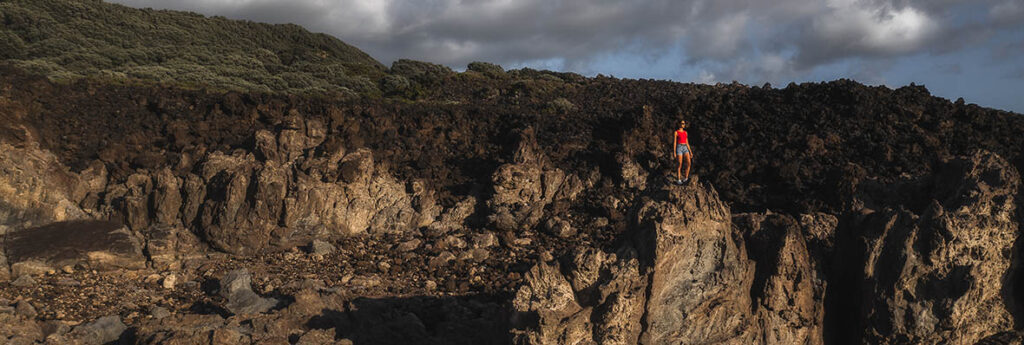About eight million years ago, the first signs of the Azores islands started to appear in the middle of the Atlantic Ocean as a result of volcanic eruptions. Eventually, nine major islands were created about 1,2000 kilometres (800 miles) west of mainland Portugal. These islands make up the Azores archipelago and are Mother Nature’s gift from the centre of earth for us to enjoy.
Lava creates interesting underwater architecture from water arches, swim-through caves and tunnels which can be viewed along the coast. On land, it creates craters and geothermal springs and land with nutrient rich soil for plant life. The islands are truly a destination for water sports enthusiasts of all levels – from those who wish to swim in a a volcanic crater or soak in a volcanic hot spring to those who want to dive with the sharks and use hyperbaric chambers.
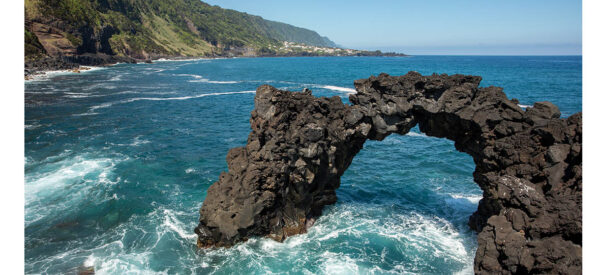 Here is where you can explore the inside of a volcano, one of the rarest experiences on earth – Algar do Carvão. Descending 90 meters (300 feet) down an ancient lava tube formed over 3,000 years ago with the world’s highest concentration of silica stalactites leads you to an incredibly rare and beautiful sight that will take your breath away. Imagine, you can even arrange to get married inside the volcano and it’s the only place in the world for such a hot spot wedding, or perhaps a special concert.
Here is where you can explore the inside of a volcano, one of the rarest experiences on earth – Algar do Carvão. Descending 90 meters (300 feet) down an ancient lava tube formed over 3,000 years ago with the world’s highest concentration of silica stalactites leads you to an incredibly rare and beautiful sight that will take your breath away. Imagine, you can even arrange to get married inside the volcano and it’s the only place in the world for such a hot spot wedding, or perhaps a special concert.
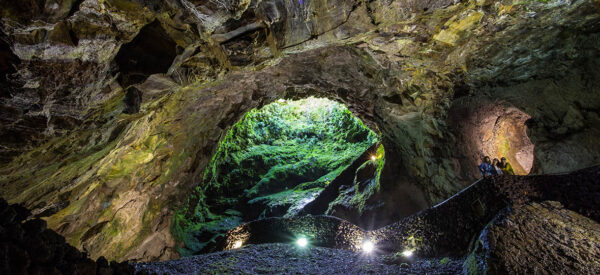
Another unique experience no other destination can offer is the geothermal dining experience known as Furnas. The ultimate foodie experience is a traditional Azorean dish that involves burying meats and vegetables in volcanic soil that is then cooked with volcanic heat. Volcanic rock eventually breaks down and forms some of the most fertile soils which can be reflected in the flavours of the Azorean cuisine that uses ingredients from local farmers and fishermen.
Descending into a volcano and eating volcano-cooked food is just the beginning of this jaw-dropping vacation. Lava also creates interesting underwater architecture in the form of water arches, swim-through tunnels and caves that can be easily viewed along the coastline by bathers, boaters and divers. On land, the lava left its mark with huge craters and thermal bathing pools. The Azores islands are definitely a water sports enthusiast’s paradise both in water and on land.
The Azores’ location and convergence of currents here makes these islands a haven for spotting amazing sea creatures. With sightings possible all year round, the waters surrounding the Azores islands are one of the largest sanctuaries for whales in the world and, therefore, one of the best places for whale watching. In addition to whales, visitors will be able to spot dolphins, sea turtles and birds in their natural environment. Scuba diving in the Azores offers world-class views of some incredible species, including blue sharks, whale sharks, mako sharks, mobula rays and manta rays.
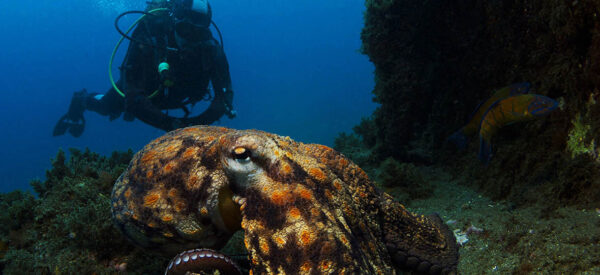 Hiking is another wonderful way to explore the Azores Islands – with over 80 trails to choose from there is something to suit every hiker from a gentle walk to challenging hikes. Bicycles and horses are also available for exploring the island along trails that lead to beautiful landscapes of the ocean or the whole island, with some of them going through thick laurel forests and others leading to hidden waterfalls, volcanic craters and ancient ruins.
Hiking is another wonderful way to explore the Azores Islands – with over 80 trails to choose from there is something to suit every hiker from a gentle walk to challenging hikes. Bicycles and horses are also available for exploring the island along trails that lead to beautiful landscapes of the ocean or the whole island, with some of them going through thick laurel forests and others leading to hidden waterfalls, volcanic craters and ancient ruins.
Along these ancient and mysterious trails, the only sounds you’re likely to hear is a cow from a nearby farm or some of the numerous migratory birds that, like the whales, pick the Azores as a resting spot during their long intercontinental trips. They know a good resting spot when they see it.
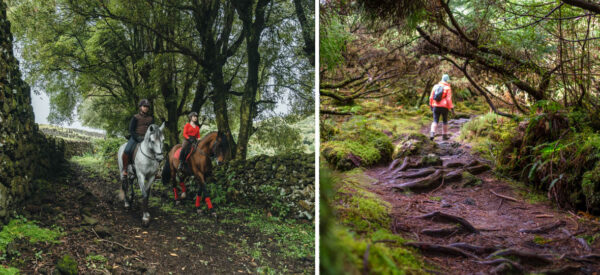
For more relaxing activities, the Azores Islands offer a vibrant culture and history, internationally recognized wine and cuisine, spa resorts with yoga and volcanic massages, UNESCO World Heritage city of Terceira’s Angra do Heroismo, the only tea plantation in Europe, natural thermal pools, fascinating caves and botanical gardens. Eating in the Azores means enjoying food that was nurtured by the special nutrients of volcanic soil and guarantees healthy meals with great flavour.
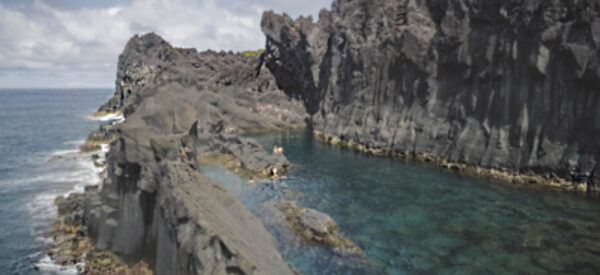
When it comes to relaxing, many believe that volcanic rock, also known as lava stone, is a grounding stone that gives one strength and courage. Supposedly, a calming stone, but then the entire Azores are a calming experience with its charming villages reminding one of the picturesque cobblestoned streets of Europe without the mass tourism. The Azores welcomes its visitors as a safe destination which is ideal for solo or senior travellers who want an off-the-beaten tourist track experience and who like to explore in isolation with nature but are concerned about safety.
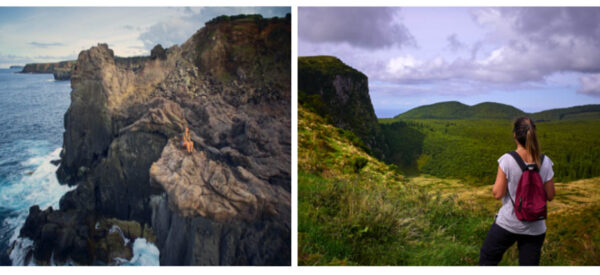 Considered one of the world’s top 10 most sustainable destinations, the Azores were again voted Europe’s Leading Adventure Tourism Destination, by World Travel Awards. Known for natural wonders like stunning waterfalls and lagoons, impossibly blue lakes, hot springs, hydrangeas, and volcanic craters, the nine islands of the Azores have been likened to “the Hawaii of the East” with their combination of lush forests, pristine beaches, and volcanic coastline.
Considered one of the world’s top 10 most sustainable destinations, the Azores were again voted Europe’s Leading Adventure Tourism Destination, by World Travel Awards. Known for natural wonders like stunning waterfalls and lagoons, impossibly blue lakes, hot springs, hydrangeas, and volcanic craters, the nine islands of the Azores have been likened to “the Hawaii of the East” with their combination of lush forests, pristine beaches, and volcanic coastline.
Yet, despite its popularity and awards, the Azoreans have a long history of protecting its natural environment and are keen on sustaining their natural beauty. They’ve learned how to harness geothermal energy and geothermal powerplants supply a significant share of the archipelago’s electricity. Renewable generation technologies are installed on all nine islands.
As of December 2019, the Azores has been officially recognized as the world’s first island archipelago to be certified under the EarthCheck Sustainable Destination program, making it one of the most sustainable tourism destinations in the whole world. This tremendous honor is one currently shared by only 13 regions across the entire globe.
Both Terceira and São Miguel islands are closer than you think. SATA Azores Airlines operates non-stop service to the islands of Terceira and Sāo Miguel, a bit over 5 hours flight time. Both Terceira and São Miguel act as gateways to the other islands. One can fly between the islands, take ferries or arrange a private water taxi depending on your island-hopping desires.
With year-round pleasant temperature and the myriad of enticing outdoor activities such as hiking, cycling, diving, snorkeling, whale watching, swimming with dolphins, canyoning, golfing, and kayaking/paddle boarding, it’s no wonder the islands are one of the favourite locations for nature and adventure tourism in the world.

